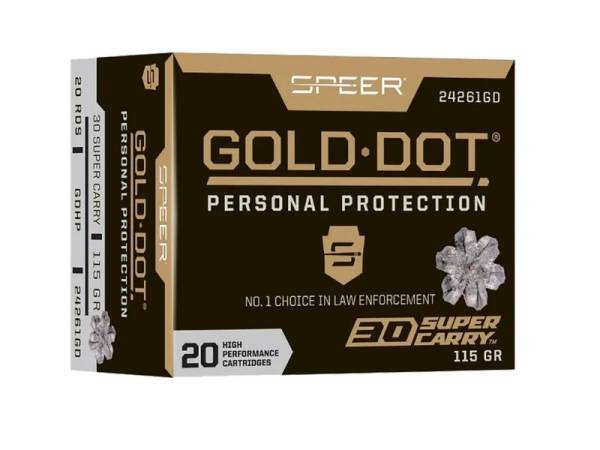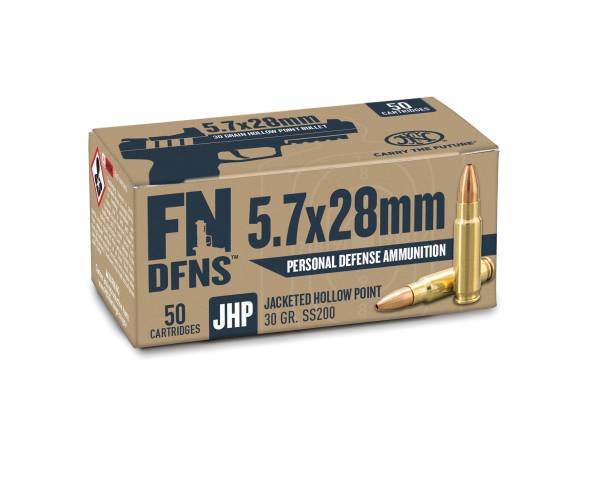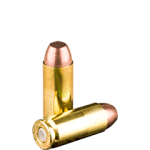Description
An iconic American cartridge, the .45 ACP was popularized in John Browning’s classic Colt Model 1911 pistol. Today it remains as popular as ever – with military, police, and civilian shooters continuing to make this cartridge their choice for personal protection.
Designed by an American, made in America, and created for the United States Armed Forces – nothing encompasses the American spirit of ammunition like the .45 Auto caliber and the gun it was made for. Known as the .45 ACP, this cartridge is the all-American bullet. And over 100 years after its debut, it’s still used by both law enforcement and civilians and remains a favorite across the US.
What is .45 ACP Ammo?
The .45 Automatic Colt Pistol (ACP), also known as the .45 Auto, is a caliber of ammunition designed by John Moses Browning in 1905. The standard ammo design holds a 230 grain (gr) lead bullet that travels at an impressive 830 feet per second (fps).
.45 Auto bullets measure 11.43 x 23mm, with a bullet diameter of .451 inch. Its casing features a slight taper – from the casing’s rim to its mouth, there’s a .003 inch difference.
Used in the military, by law enforcement, by civilians for personal protection, and as a first-class match cartridge, the .45 ACP gives its shooter ammunition that’s accurate and has excellent stopping power. While it can take some practice to become effective with these rounds, it often becomes a favorite to shoot.
Development of the .45 ACP
When Browning created the .45 Auto, he was looking for a replacement for the “less than stellar” .38 Long Colt cartridge for the US military. The US Cavalry had determined that they lacked an efficient and effective bullet and that the calibers they currently had available did not pose big enough threats to their enemies.
Army weaponry at the time included the 1860 Colt Army and the 1873 Single Action Army, but the .44 ball and .454 flat-tipped bullets didn’t expand or create the ideal damage. After field-testing a number of calibers in 1904, it was determined that nothing less than a .45 bullet would have the stopping power the military was looking for. Military stipulations also included a firearm that could hold no less than six rounds, a bullet that weighed at least 230 gr, and a trigger pull that was no less than six pounds.
In 1905, Browning introduced his first .45 ACP cartridge to the US Army, along with what would become his prototype for the iconic M1911 pistol. The original 200 gr bullet traveled 900 feet per second, but Browning tested the weapon and cartridge over the next six years, making modifications until it became what it still is to this day – ammo with an increased bullet weight of 230 gr (while keeping the same powder load) and a decreased muzzle velocity of 830 feet per second. These features remained the standard load for the .45 ACP throughout its service life and into today.
The Success of the M1911 and the .45 ACP
In March of 1911, the Army set forth on the final testing to determine its new service weapon. The choices had been narrowed down to a Savage and a Colt, with casings covered in acid and sand and each weapon firing 6,000 rounds. Of the rounds fired, the Savage had only 37 incidents. The Colt had none, and the M1911 became the official weapon of the US Armed Forces.
The success of the M1911 is one of the reasons the .45 ACP cartridge rose in popularity. Over its course, the firearm and its cartridge became the longest-serving pistol of any military force, and it remains an icon among gun collectors and enthusiasts.
Numerous stories circulate about the role the M1911 has played in our military history. At least 68 awardees of the Medal of Honor have carried the .45 ACP and the M1911 pistol in the course of their heroic actions. In one such act during World War I, Sergeant Alvin York used his .45 ACP to single-handedly kill six German soldiers while assaulting their machine gun emplacements, supporting the claim that the cartridge is an excellent man stopper.
Why is the .45 ACP So Popular?
The .45 ACP grew in popularity outside of the Armed Forces due to its ability to adapt to a variety of shooting applications, including sport shooting, law enforcement, and self-defense. Both target shooters and backyard shooters appreciate the .45 ACP for its accuracy, mild recoil, and heavy bullet.
Law enforcement agencies have chosen the .45 ACP for its proven ability to stop dangerous aggressors. Units such as the FBI’s Hostage Rescue Team and the Los Angeles Police Department SWAT, as well as other specialized units, carry firearms chambered in the .45 Auto.
The US military officially replaced the .45 ACP with the 9mm in 1985, though it continues to have pockets of dedicated users in the service. Operators of the Marine Expeditionary Units, Delta Force, and others within the purview of the United States Special Operations Command have the option of using pistols chambered in the .45 ACP.
As a self-defense weapon, in its basic full metal jacket (FMJ) cartridge, the non-expanding .45 Auto is heavy and penetrates deep. The large bullet diameter creates a significant wound, which can damage the central nervous system, circulatory system, and critical organs. Those looking for personal protection may also opt for specialty configurations from a variety of ammunition manufacturers, including Hornady, Federal, and Magtech.
Another reason that contributes to the .45 Auto’s popularity is its affordability. Shooters who want to stock up will find that buying bulk .45 ACP ammo will result in some of the best .45 ammo prices.
Different Types of .45 ACP Ammunition
Like other cartridges, the .45 ACP is available in a range of different types and styles. Some of the most common .45 Auto ammo includes:
Full metal jacket (FMJ): .45 FMJ ammo features a lead bullet encased with a copper or other hard metal coating, helping the bullet keep its form until impact. People sometimes refer to these cartridges as full metal case (FMC) ammo.
Jacketed hollow point (JHP): .45 ACP JHP ammo also has a lead bullet encased in hard metal, but instead of a round ball, the bullet has a hollow point inside – which makes it expand on impact, increasing its stopping power.
Advanced energy transfer (AET): AET ammo, also called frangible ammunition, looks like standard ammo, but when it hits its target, this bullet fragments into tiny pieces of composite materials (as long as the target is harder than the bullet).
Total metal jacket (TMJ): Much like the FMJ, the TMJ features a bullet completely covered in hard metal. The difference between the two is that FMJ ammo exposes a small amount of lead at the base of the bullet, but TMJ completely covers the bullet – minimizing the shooter’s lead exposure.
What Are Some Popular .45 ACP Pistols?
While .45 ACP ammo is popular – especially .45 bulk ammo – the guns that fire this ammunition make it so. The Colt M1911 was the first of many .45 caliber pistols that American law enforcement, special forces, and civilians flocked to. Other popular .45 caliber firearms include:
Beretta PX4 Storm
Smith & Wesson M&P
Ruger SR
Springfield Armory XD(M)
Glock 21
Sig Sauer P220
Beyond these semi-automatic pistols, multiple submachine guns have been chambered for the .45 ACP. Reising designed and manufactured a .45 Auto semi-automatic rifle in the 1940s.
Popular .45 ACP Ammo Manufacturers
A wide range of ammunition manufacturers make .45 ACP ammunition. Popular brands include:
Federal
Fiocchi
Wolf
Remington
Blazer Brass
PMC
Magtech
Sellier & Bellot
Are There Other Types of .45 Cal Ammo?
While the .45 ACP is by far the most popular .45 ammunition, there are others that have been made with this size bullet. Some of the most common calibers are:
.45 Colt: The .45 Colt ammunition was designed for the 1873 Peacemaker single-action revolver. Many often wonder about the difference between 45 Colt vs. 45 ACP ammo – the former was a heavy, fast-moving bullet at 255 gr and 900+ fps, and was vital in settling and civilizing the American West. 45 ACP is very similar, with a 230 grain (gr) lead bullet that travels at an impressive 830 feet per second (fps).
.45 S&W (Schofield): Designed for the 1875 Smith & Wesson Schofield revolver, this chamber was used heavily during the turn of the century and may have been used by General Custer at the Battle of Little Bighorn. While .45 S&W ammo can be used in most Colt .45 revolvers, .45 Colt ammo should not be used in .45 S&W pistols.
.45 Automatic Rimmed (Auto Rim): Because the .45 ACP casing is rimless, it requires a half-moon clip. To solve this problem, a rimmed version, the .45 Auto Rim, was created. While it never caught on in mainstream popularity, those who prefer remanufactured ammunition and .45 caliber for hunting may use it.
.45 Glock Auto Pistol (GAP): The .45 GAP is made exclusively for Glock 37s, 38s, and 39s. These cartridges are one-eighth inch shorter than standard .45 ACP ammo but feature the same performance. This smaller casing allows for a narrow magazine and a smaller firearm frame and grip. Along with the pistols chambered for .45 GAP, Glock also offers multiple gun models chambered in .45 ACP.
.45 Automatic Short (HP): In some countries, including Italy, France, and Mexico, citizens are not allowed to carry firearms chambered in a military cartridge – which makes any .45 ACP gun illegal. To get around this, the .45 HP has a casing that is 1mm shorter than the standard .45 Auto. Most .45 ACP pistols can be converted to a .45 HP by replacing the standard barrel with a shorter one.
.45 Automatic Match: While .45 Automatic Match ammunition features the same chambering and dimensions of .45 ACP ammo, it has a smaller casing with a reduced powder load. These rounds are accurate and used in bullseye target shooting.
.45 ABC Mi-Bullet: Created by Advanced Ballistics Concepts, LLC (ABC), the multiple-impact (Mi) bullet is multi-part ammunition that increases the shooter’s hit probability in a self-defense situation. Featuring a bullet that divides into pieces tethered together like a web, it provides multiple strike points and up to a 10-inch impact diameter.
.45 ACP vs. 9mm Ammunition
For personal defense, law enforcement, and overall efficiency, the battle between .45 ACP and 9mm Luger (or Parabellum) remains intense. While each side has valid points, it should be noted that with practice, both calibers are lethal.
In May 2014, the FBI released a report on their decision to opt for the 9mm over other caliber options, including the .45 ACP. Because of modern ballistic technology, the 9mm’s small cartridge and bullet size didn’t have as large an impact on penetration and stopping power as they had in the past. With today’s ammunition, the 9mm cartridge has grown into a deadly caliber that offers some benefits over the classic .45 Auto.
When all things are factored in, including the cost of ammunition, magazine capacities, and the impact of recoil, many shooters are faster and more accurate with 9mm than larger caliber cartridges. Yet, the .45 ACP offers accuracy and precision that sport shooters have chosen for years.
The unparalleled accuracy, reliability, and carry capacity of a practiced .45 ACP pistol can’t compare to other pistols. Once a shooter gets comfortable with .45 ACP rounds, it quickly becomes their go-to caliber. After more than a century of use, the .45 ACP is a cartridge that has been modified and studied extensively and is still used all over the world. Today, it remains one of the most prized cartridges on the market and can be found in gun cabinets across the country.
FAQ
What is 45 ACP ammo?
The .45 Automatic Colt Pistol, commonly called the .45 ACP or .45 Auto, refers to a handgun cartridge developed by famous American gunsmith John Moses Browning in 1905. This ammo, which measures in at 11.43×23mm, was the standard cartridge for Browning’s Colt semi-automatic pistol. It also became the standard chambering for Colt’s M1911 pistol after going through successful military trials. It is still used by some branches of the military today, as well as many law enforcement officers. It is also a favorite among many American pistol shooters.
What is the best 45 ACP ammo?
The best .45 ACP ammo depends on the shooter’s needs, purpose, and preferences. For those who are target shooting at the range, they may opt for .45 Auto FMJ, or full metal jacket rounds. These bullets are affordable, great for practice, and can often be found in bulk. For those who want cheap .45 ACP ammo, consider cartridges with steel casings, while those interested in reloading may want to choose brass shells. Shooters carrying concealed ideally use something with less penetration and more stopping power, like a jacketed hollow point (JHP) cartridge.
What is the best 45 ACP ammo for self-defense?
When using .45 ACP ammo for self-defense, consider using jacketed hollow point or JHP, ammunition. When compared to traditional full metal jacket bullets, the JHP projectiles bring more stopping power and less risk of over-penetration, which is always a concern in a self-defense scenario. JHP is designed specifically to expand on impact, making them less likely to go through the shooter’s target. Many brands make .45 ACP cartridges specifically for self-defense, including Hornady, Federal, and Winchester.
What is the best 45 ACP ammo for target shooting?
When choosing .45 ACP ammunition for target shooting, many shooters opt for full metal jacket (FMJ) rounds. These rounds are affordable, easy to find, and can even be purchased as bulk ammo. For those who engage in competitive target shooting, semi-wadcutter (SWC) rounds may be a better option. SWC ammo creates clean cuts on paper targets, making them easier to judge and score.
What 45 ACP ammo does the military use?
Throughout the years, the US Military has used a variety of .45 ACP ammo. The official Military round is listed as the “Cal. 45 Automatic Pistol Ball Cartridge, Model of 1911.” It is a 1.273 inch cartridge with a 230-grain full metal jacket (FMJ) bullet housed in a brass casing, which was first produced at Frankford Arsenal. The US Armed Forces have used different variations of the .45 Auto over the years, including wadcutter, tracer, and line throwing rounds. Since 2015, the military has been switching to jacketed hollow point (JHP) cartridges for combat, as they’re more effective and have a greater stopping power than the traditional FMJ.





